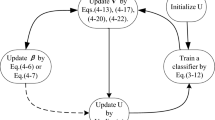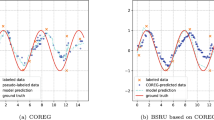Abstract
While a testing sample may be first encoded linearly with labeled samples and then classified with KNN on the sum of the obtained weights of the samples in each class so as to avoid the consistent distribution assumption explicitly or implicitly used in most of the existing classification methods for training and testing samples, a novel self-paced and Bayes-decision-rule linear KNN prediction method SBLD-KNN in this study will be proposed to achieve three goals: (1) class-ware information will be explicitly reflected in a grouping effect regularization term so as to share the sparsity of a linear encoder and simultaneously have grouping effect of weights on each class; (2) the resultant predictor behaves like Bayes-decision-rule for minimum error; (3) self-paced regularized term is designed to adaptively truncate the weights of labeled samples for enhancing generalization. In order to do so, the corresponding objective function of SBLD-KNN is designed and then optimized by using the alternating optimization strategy, and its Bayes-decision-rule is theoretically analyzed. Our experimental results on benchmark datasets witness the effectiveness of SBLD-KNN, in contrast to the comparative methods, including SBLD-KNN’s simplified version BD-KNN with weight’s truncating rather than self-pacing.



Similar content being viewed by others
Explore related subjects
Discover the latest articles and news from researchers in related subjects, suggested using machine learning.References
Pourpanah F, Wang R, Wang X (2019) Feature selection for data classification based on binary brain storm optimization. In: 2019 IEEE 6th international conference on cloud computing and intelligence systems (CCIS), 19–21 Dec. 2019, pp 108–113. https://doi.org/10.1109/CCIS48116.2019.9073751
Chan PP, Wang Y, Yeung DS (2020) Adversarial attack against deep reinforcement learning with static reward impact map. In: Proceedings of the 15th ACM Asia conference on computer and communications security, pp 334–343
Mo D, Lai Z, Wang X, Wong W (2020) Jointly sparse locality regression for image feature extraction. IEEE Trans Multimed 22(11):2873–2888. https://doi.org/10.1109/TMM.2019.2961508
Chan PPK et al (2018) Face liveness detection using a flash against 2D spoofing attack. IEEE Trans Inf Forensics Secur 13(2):521–534. https://doi.org/10.1109/TIFS.2017.2758748
Lian G, Wang Y, Qin H, Chen G (2021) Towards unified on-road object detection and depth estimation from a single image. Int J Mach Learn Cybern. https://doi.org/10.1007/s13042-021-01444-z
De A, Guo C (2014) An image segmentation method based on the fusion of vector quantization and edge detection with applications to medical image processing. Int J Mach Learn Cybern 5(4):543–551. https://doi.org/10.1007/s13042-013-0205-1
Premachandra C, Premachandra HWH, Parape CD, Kawanaka H (2015) Road crack detection using color variance distribution and discriminant analysis for approaching smooth vehicle movement on non-smooth roads. Int J Mach Learn Cybern 6(4):545–553. https://doi.org/10.1007/s13042-014-0240-6
Zhang J, Liu D, Ma Y (2021) Delay-dependent stability analysis of nonlinear truck-trailer systems based on non-fragile memory sampled-data via fuzzy control. Int J Mach Learn Cybern 12(12):3475–3490. https://doi.org/10.1007/s13042-021-01386-6
Zheng W, Liu H, Wang B, Sun F (2020) Cross-modal learning for material perception using deep extreme learning machine. Int J Mach Learn Cybern 11(4):813–823. https://doi.org/10.1007/s13042-019-00962-1
Zhao L, Zhu J (2019) Learning from correlation with extreme learning machine. Int J Mach Learn Cybern 10(12):3635–3645. https://doi.org/10.1007/s13042-019-00949-y
Zhu H, Wang X, Wang R (2021) Fuzzy monotonic K-nearest neighbor versus monotonic fuzzy K-nearest neighbor. IEEE Trans Fuzzy Syst. https://doi.org/10.1109/TFUZZ.2021.3117450
France S, Carroll D (2009) Is the distance compression effect overstated? Some theory and experimentation. In: Perner P (ed) Machine learning and data mining in pattern recognition. Springer, Berlin, pp 280–294
Bian Z, Ishibuchi H, Wang S (2019) Joint learning of spectral clustering structure and fuzzy similarity matrix of data. IEEE Trans Fuzzy Syst 27(1):31–44. https://doi.org/10.1109/TFUZZ.2018.2856081
Bian Z, Vong CM, Wong PK, Wang S (2020) Fuzzy KNN method with adaptive nearest neighbors. IEEE Trans Cybern. https://doi.org/10.1109/TCYB.2020.3031610
Shan H, Zhang J, Kruger U (2015) Learning linear representation of space partitioning trees based on unsupervised kernel dimension reduction. IEEE Trans Cybern 46(12):3427–3438
Wang J, Yang J, Yu K, Lv F, Huang T, Gong Y (2010) Locality-constrained linear coding for image classification. In: 2010 IEEE computer society conference on computer vision and pattern recognition. IEEE, pp 3360–3367
Zhong LW, Kwok JT (2012) Efficient sparse modeling with automatic feature grouping. IEEE Trans Neural Netw Learn Syst 23(9):1436–1447
Tibshirani R (1996) Regression shrinkage and selection via the lasso. J Roy Stat Soc Ser B (Methodol) 58(1):267–288
Liu Q, Liu C (2016) A novel locally linear KNN method with applications to visual recognition. IEEE Trans Neural Netw Learn Syst 28(9):2010–2021
Jiang L, Meng D, Yu S-I, Lan Z, Shan S, Hauptmann A (2014) Self-paced learning with diversity. Adv Neural Inf Process Syst 27:2078–2086
Kumar MP, Packer B, Koller, D (2010) Self-paced learning for latent variable models. In: Lafferty J, Williams CKI, Shawe-Taylor J, Zemel RS, Culotta A (eds) Advances in neural information processing systems. vol 23, pp 1189–1197
Jiang L, Meng D, Mitamura T, Hauptmann AG (2014) Easy samples first: Self-paced reranking for zero-example multimedia search. In: Proceedings of the 22nd ACM international conference on multimedia, pp 547–556
Supancic JS, Ramanan D (2013) Self-paced learning for long-term tracking. In: Proceedings of the IEEE conference on computer vision and pattern recognition, pp 2379–2386
Fukunaga K (2013) Introduction to statistical pattern recognition. Elsevier, Amsterdam
Dong A, Chung F-L, Deng Z, Wang S (2015) Semi-supervised SVM with extended hidden features. IEEE Trans Cybern 46(12):2924–2937
Jiang Y, Chung F-L, Ishibuchi H, Deng Z, Wang S (2014) Multitask TSK fuzzy system modeling by mining intertask common hidden structure. IEEE Trans Cybern 45(3):534–547
Deng Z, Jiang Y, Chung F-L, Ishibuchi H, Wang S (2012) Knowledge-leverage-based fuzzy system and its modeling. IEEE Trans Fuzzy Syst 21(4):597–609
Wright SJ (2015) Coordinate descent algorithms. Math Progr 151(1):3–34
Zhang M-L, Zhou Z-H (2007) ML-KNN: A lazy learning approach to multi-label learning. Pattern Recogn 40(7):2038–2048
Frank A, Asuncion A (2010) UCI machine learning repository, 2010. [Online]. Available: http://archive.ics.uci.edu/ml
Alcalá-Fdez J, Fernández A, Luengo J et al (2011) Keel data-mining software tool: data set repository, integration of algorithms and experimental analysis framework. J Multiple-Valued Logic Soft Comput 17:255–287
Hui Z, Hastie T (2005) Regularization and variable selection via the elastic net. J Roy Stat Soc 67(5):768–768
Kollios G, Gunopulos D, Koudas N, Berchtold S (2003) Efficient biased sampling for approximate clustering and outlier detection in large data sets. Knowl Data Eng IEEE Trans 15(5):1170–1187
Scott DW (2015) Multivariate density estimation: theory, practice, and visualization[M]. Wiley
Fawcett T (2006) An introduction to ROC analysis. Pattern Recogn Lett 27(8):861–874
Hao H, Wang J, Abudureyimu H (2012) Maximum F1-score discriminative training for automatic mispronunciation detection in computer-assisted language learning. In: Interspeech 2012, pp 815–818
Gu S, Chung F-L, Wang S (2019) A novel deep fuzzy classifier by stacking adversarial interpretable TSK fuzzy sub-classifiers with smooth gradient information. IEEE Trans Fuzzy Syst 28(7):1369–1382
Demšar J (2006) Statistical comparisons of classifiers over multiple data sets. J Mach Learn Res 7:1–30
Bertini JR Jr, Zhao L, Motta R, de Andrade Lopes A (2011) A nonparametric classification method based on k-associated graphs. Inf Sci 181(24):5435–5456
Gönen M, Alpaydın E (2011) Multiple kernel learning algorithms J. Mach Learn Res 12:2211–2268
Zhang T, Deng Z, Wu D, Wang S (2018) Multiview fuzzy logic system with the cooperation between visible and hidden views. IEEE Trans Fuzzy Syst 27(6):1162–1173
Mathew J, Pang CK, Luo M et al (2017) Classification of imbalanced data by oversampling in kernel space of support vector machines. IEEE Trans Neural Netw Learn Syst 29(9):4065–4076
Zar JH (1999) Biostatistical analysis. Pearson Education India, Noida
Nash MS (2001) Handbook of parametric and nonparametric statistical procedures. Technometrics 43(3):374
Beck A, Teboulle M (2009) A fast iterative shrinkage-thresholding algorithm for linear inverse problems. Siam J Imaging Sci 2(1):183–202
Acknowledgements
This work was supported in part by the National Natural Science Foundation of China under Grants U20A20228, 61772198, 6197071117, by the Natural Science Foundation of Jiangsu Province under Grant BK20191331, and by National First-class Discipline Program of Light Industry and Engineering (LITE2018). (Corresponding author: Shitong Wang). (Jin Zhang and Zekang Bian have equal contribution to this work).
Author information
Authors and Affiliations
Corresponding author
Additional information
Publisher's Note
Springer Nature remains neutral with regard to jurisdictional claims in published maps and institutional affiliations.
Rights and permissions
About this article
Cite this article
Zhang, J., Bian, Z. & Wang, S. Self-paced and Bayes-decision-rule linear KNN prediction. Int. J. Mach. Learn. & Cyber. 13, 3267–3283 (2022). https://doi.org/10.1007/s13042-022-01593-9
Received:
Accepted:
Published:
Issue Date:
DOI: https://doi.org/10.1007/s13042-022-01593-9




